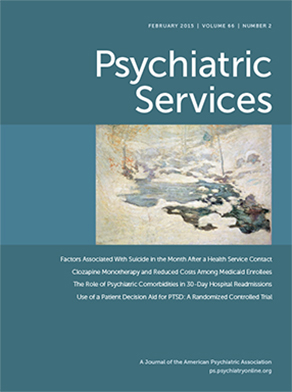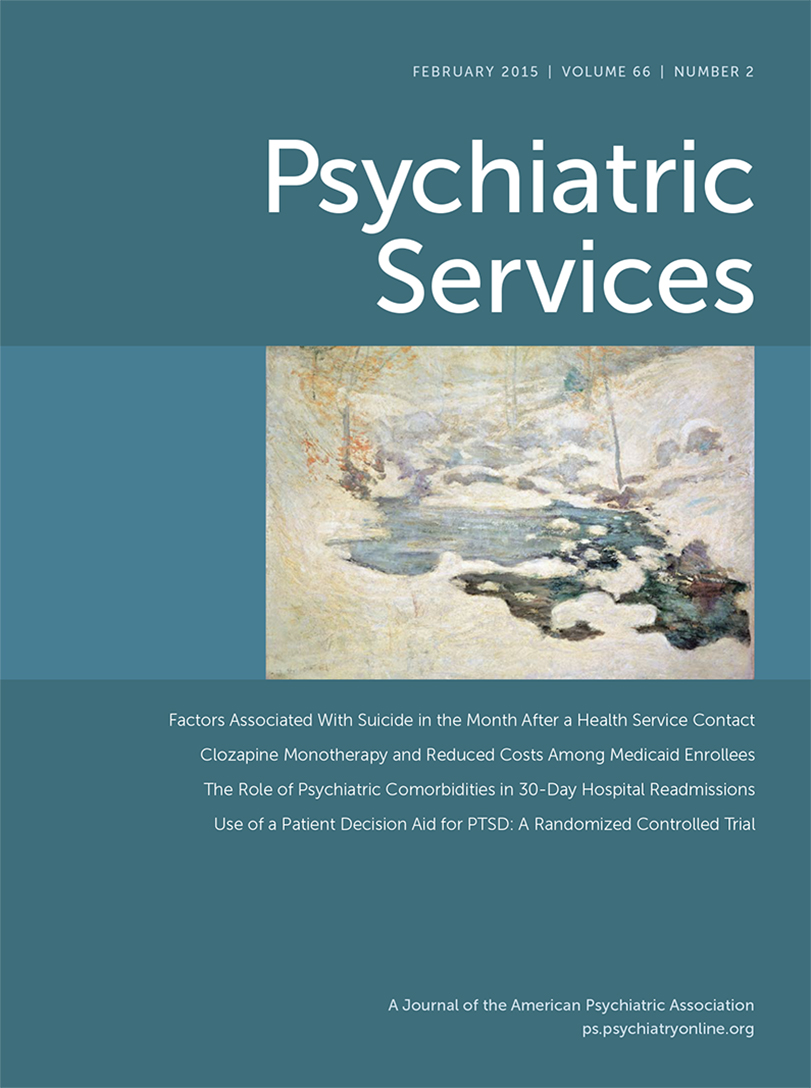Federal, state, and local behavioral health care systems each have their own set of rules, as well as mandatory policies and procedures to which providers must adhere to stay in business. This creates a large number of deadlines, regulations, license requirements, and financial obligations that providers must routinely meet. Despite the variety of expectations, goals, and objectives from the various providers, there are several intersecting themes: ensuring quick and efficient access to care, maintaining high consumer satisfaction, and safeguarding financial solvency. A current theme involves improving the intake process, because behavioral health care providers often lose money when appointments are missed and when individuals are not engaged and retained in treatment (
1,
2).
How can providers go about redesigning their “broken” intake processes? To improve and standardize the intake process at Wesley Spectrum Services (WSS) outpatient sites, this nonprofit service provider formed a partnership and worked collaboratively with Allegheny HealthChoices, Inc. (AHCI), a nonprofit oversight and monitoring agency for behavioral health services, and with researchers from the University of Houston and Clemson University. The result of this collaboration was a redesigned intake process that increased access to care by 43%, delivered high-quality care to consumers, drastically decreased WSS’s bad debt, and increased its financial collection rates. The researchers and AHCI staff provided their expertise and services in kind to support this initiative, and thus there were no out-of-pocket expenses.
Forming a Partnership
In preliminary discussions, the collaborators identified the goal of redesigning and streamlining the intake process for WSS’s operations in the greater Pittsburgh area. Because this would be a process redesign, the researchers suggested using a product and service development approach called Design for Six Sigma (DFSS). DFSS is a structured, problem-solving approach that builds quality into the design of products and services (
3). Preliminary discussions among the collaborators focused on how to make the collaboration a win-win for all. That is, the three parties involved specifically identified how they would each benefit from this partnership. WSS would learn new skills to help redesign its intake process. In addition to learning new skills, AHCI would be engaged in supporting WSS’s efforts to increase access to care, leading the project by using project management and quality improvement methods. Finally, the researchers would gain insights into how structured improvement methods, such as DFSS, help improve outcomes—not only in behavioral health care but also in services. The researchers also were responsible for coaching and mentoring the project team through a learning collaborative approach.
Use of learning collaboratives and the DFSS methodology have led to positive outcomes in other industries, but these approaches have not been widely applied in the behavioral health arena (
3,
4). Virtual learning sessions to teach the DFSS methodology were held by the researchers on a routine basis for the benefit of the project team. The learning sessions provided instruction about use of this structured, problem-solving approach, which assisted the project team in efficiently assessing the highest-priority needs, creating a new process that effectively addressed those needs, and implementing change successfully within the organization. The specific approach and improvement methods used in this project are summarized in
Table 1 (
3,
5).
Defining the Problem and Process
The project team began by establishing a project charter that included problem and mission statements. The following problem statement was developed: “The current intake process for WSS is managed differently at its seven different outpatient sites, which decreases consumers’ access to care and creates administrative inefficiencies.” The following mission statement was also developed: “Redesign the intake process for outpatient services within WSS’s outpatient sites by creating a standard, centralized admissions department, with a focus on improving access to care.”
These statements provided a firm objective to guide the team’s work. Next, the team identified the parties, elements, and steps generally involved in the intake process and depicted this information in a “suppliers, inputs, process, outputs, and customers” (SIPOC) diagram. The SIPOC diagram was later used to help create a current-state process map, which showed step-by-step details regarding the operation of the intake process. At all WSS’s outpatient sites, the intake process began when an individual communicated that he or she had a need for a behavioral health service. The intake staff inquired about the individual’s insurance coverage. If the insurance was accepted, a profile of the individual was created in WSS’s electronic medical record. The individual was then screened for the service that would best fit his or her needs. A clinician at the site was assigned, and an appointment was scheduled. Unfortunately, many variations of this basic process were used across WSS’s seven outpatient sites. Therefore, a goal of the redesign project was to standardize the intake process.
Identifying Needs
The team next researched the needs or desires of those involved in the intake process. First, team members conducted 14 interviews with current intake staff. The interviews inquired about uses, likes, dislikes, and suggestions for improvements to the intake process. Seventy-four needs were identified. The project team organized these need statements into groups on the basis of common themes by using an affinity diagram. Themes included topics such as billing operations, consumer needs assessments, and intake staff training. Project team members used their expertise to select the 25 most important needs. These items were included in a needs prioritization survey administered to 25 of WSS’s intake staff on which staff indicated the importance of these features of the intake process by using a Likert scale from 1, undesirable feature, to 5, critical feature. Responses were received from 21 (84%) staff members. The project team identified 11 needs that 50% or more of respondents rated as critical. These top-rated needs became the focus of the redesign project.
Creating the New Process
To continue the redesign process, the team conducted brainstorming and benchmarking sessions to solicit ideas about how to meet the 11 top-rated needs. Some questions asked of participants included: How do you/could we increase consumer satisfaction related to receiving timely access to services? How do you/could we effectively document the insurance eligibility procedural process? How do you/could we ensure a more prompt cash flow by reducing the amount of time fees are in accounts receivable?
To prevent bias and obtain a broad range of ideas, both staff who were traditionally part of the intake process and those who were not were asked to participate in these sessions. For example, WSS intake staff members who were not previously interviewed or surveyed were asked to participate. Separate sessions were held for several individuals who did not work for WSS but who were thought to be knowledgeable about intake processes, such as representatives from the Department of Human Services. From these sessions, 75 unique ideas were obtained, such as using a question checklist to guide the first few minutes of intake phone calls with consumers and establishing the first appointment before ending the call. The project team again used an affinity diagram to organize and make sense of these ideas. The team then used “multivoting” to identify the top ten ideas to guide the rest of the intake redesign project. Multivoting is a group decision-making technique used to prioritize ideas by having people cast votes for multiple ideas or items under consideration and tallying the results (
5). Some ideas included providing timely access to services, encouraging prompt payment mechanisms, and supporting service collaboration at the first point of contact.
Implementing and Verifying the Redesigned Process
The implementation of the redesigned intake process proved to be the biggest challenge of the initiative because it involved completely restructuring the duties of intake personnel. Specifically, it required a thorough review of all job duties within the intake process, reassignment of individuals to different roles at WSS, and creation of new job roles. One reason that this was so challenging was that the redesigned intake process could not be implemented by the project team alone. The team had to collaborate with many others, such as executive leaders and human resources personnel. A final presentation of the proposed changes was made to the executive leadership team, whose members had been strong supporters of the project from the beginning.
Once implemented, a comparison of pre- and postmeasures indicated that access to care increased by 43% (from a wait time of 8.6 days to a wait time of 4.9 days), consumer satisfaction remained high, bad debt and uncollected funds decreased by 81% (from $21,991 in the third quarter of 2012 to $4,073 in the fourth quarter of 2013), and cash flow improved because of the reduction in insurance denials. In addition, staff also felt more confident about performing their respective, redesigned job duties.
Supporting an Uncommon Collaboration
Before this redesign project, the intake process was not well structured because staff were often unaware of what they needed to do and different intake practices were used at different sites. Now, staff have a detailed description of the new, streamlined intake process available at their work stations to guide their work. The success of the redesign project is attributable to the use of the DFSS methodology, which supported the hard work of the project team members and many others to improve service quality through organizational change. In this column, we have described the tools and methods used in the project with the goal of helping others redesign existing processes or design new processes for the benefit of their organizations.
In retrospect, we can say that a redesign initiative should not be taken lightly. It is a large undertaking for all parties. This project lasted approximately 18 months (five months to develop the new design and 13 months to implement it). The support of senior leaders, the individuals selected for the project team, and the learning collaborative approach proved to be immensely beneficial. The project brought together a behavioral health care provider, a nonprofit oversight and monitoring agency for behavioral health services, and academic researchers. The collaboration afforded a depth of knowledge and insight that would have been almost impossible to obtain without seeking costly outside consultation. This type of collaborative effort is not frequently undertaken, particularly on a pro bono basis. However, as Henry Ford said, “Coming together is a beginning; keeping together is progress; working together is success” (
6). Indeed, the partnership was a success for all involved.
Acknowledgments
The authors thank the staff and management at WSS and AHCI who participated in or supported this study. Without them, the research and partnership would not have been possible.
The authors report no financial relationships with commercial interests.

